The U.S. Army has awarded three contracts worth about $5 million each to General Dynamics C4 (NYSE: GD), Raytheon (NYSE: RTN) and Rockwell Collins (NYSE: COL) – the three contenders selected to develop new ‘system of systems’ to equip dismounted commanders. In addition, each of the contenders will receive about $7 million upon delivering the initial prototypes, by November this year. The system, known as ‘Ground Soldier Ensemble’ (GSE) is a follow-on to the ‘Land Warrior’ which was put to a limited use in Iraq in the past year. The Army plans to buy over 11,000 systems by 2015 and, while the program is currently focused on the Army, the US Marine Corps could also join, significantly expanding the program’s scope. GSE will be designed to improve situational awareness, decreased reaction times, and reduce the risk of fratricide.
The development of the system builds on the experience gained with the Land Warrior system, developed by General Dynamics C4 and deployed with the 4/9 Infantry in Iraq. The performance of Land warrior validated the need for a dismounted battle command system while highlighting some of the current systems’ limitations. While the Army terminated the Land Warrior program due to competing priorities and total ownership cost concerns, it became clear that the need for such systems still exists. The Army defined the path forward with the future ‘Ground Soldier System’ (GSS). The first increment of GSS is the GSE, focusing on improving battle command and situational awareness.
The system improves situational awareness and network connectivity capabilities of dismounted leaders at various echelon levels within a brigade combat team. Employing mature technologies, that when integrated together on the Soldier, minimize the size, weight and power impacts to the soldier. The system will be designed as modular kits, enabling the user to tailor it for specific mission requirements, better balancing combat load configuration, and streamlining maintenance.
The companies selected for the technology development phase are expected to submit 10 system prototypes by the end of the year. These kits will include displays, computers, user input devices, navigation systems, antennas and cabling harnesses. Each of the contractors will deliver 60 additional systems through the ‘refinement phase’ to support ‘Limited User Test’ (LUT) by the Army, leading to the final selection of the system by early 2011.
Initially, the system will utilize three different man-portable radio sets. A digital data networking will be supported by an Enhanced Position Location Reporting System (EPLRS) RT-1922 while combat-net communication to platoon, battalion and higher will be supported by the Multiband Inter/Intra Team Radio AN-PRC-148. Intra-squad communications and position reporting from squad members to their leader will be provided by GPS embedded SFF-C(V1) Rifleman Radio, to be distributed to all squad members. At a later phase, the set will be upgraded through planned product improvement process, introducing JTRS Small Form Factor (SFF) radio replacing both EPLRS and AN-PRC-148 with a single voice/data set.
The computer system will run on core Army Battle Command software and Force XXI Battle Command, Brigade-And-Below (FBCB2) modules to generate and update the situational picture, blue force tracking (BFT), planning and reporting. The use of common software modules will ensure the GSE maintains interoperability with evolving Army digital network standards and capabilities. The low-power data processor will utilize an embedded multi-speed computer to extend field operation. It will be integrated with hands-free color VGA (800 x 600) resolution display and controlled from a hand-held data input device, display and controller. The computer will run a secure LINUX operating system with graphical user interface, running database, mapping, navigation, user authentication, and digital voice/data transmissions.
GSE will be powered by High capacity lithium-ion battery (rechargeable) LI-145 or LI-80. The Army has already decided to use Aereo of the 3M group and the Norwegian company NACRE, developer of the QuietPro+ combat hearing protection and earphone products.
One of the companies receiving the development contract, Rockwell Collins have formed a teaming agreement with Boeing and Elbit Systems of America, to establish ‘Team Spartan’ to compete for the program. As part of the team,
Elbit Systems of America will leverage its global soldier systems experience and lessons learned in rugged military computing technologies, including the battle-proven, soldier-worn Dominator computing system developed for the Israel Defense Force (IDF), to bring required computing capability to the program. Wearable computing platforms developed by the company support mission planning, situational awareness, target handling and device connectivity, as well as video and map displays.



















